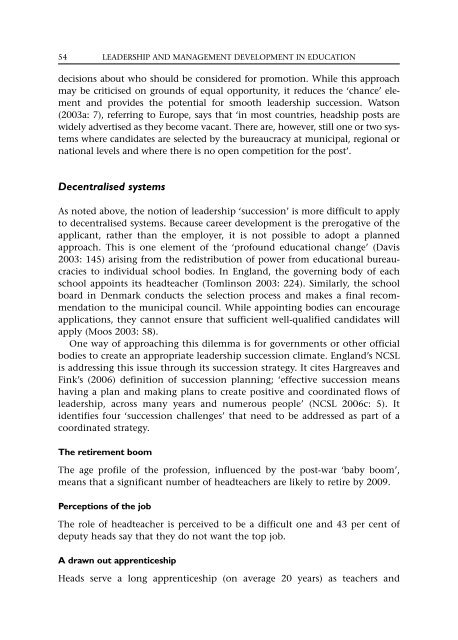Leadership and Management Development in Education (Education ...
Leadership and Management Development in Education (Education ...
Leadership and Management Development in Education (Education ...
You also want an ePaper? Increase the reach of your titles
YUMPU automatically turns print PDFs into web optimized ePapers that Google loves.
54LEADERSHIP AND MANAGEMENT DEVELOPMENT IN EDUCATIONdecisions about who should be considered for promotion. While this approachmay be criticised on grounds of equal opportunity, it reduces the ‘chance’ element<strong>and</strong> provides the potential for smooth leadership succession. Watson(2003a: 7), referr<strong>in</strong>g to Europe, says that ‘<strong>in</strong> most countries, headship posts arewidely advertised as they become vacant. There are, however, still one or two systemswhere c<strong>and</strong>idates are selected by the bureaucracy at municipal, regional ornational levels <strong>and</strong> where there is no open competition for the post’.Decentralised systemsAs noted above, the notion of leadership ‘succession’ is more difficult to applyto decentralised systems. Because career development is the prerogative of theapplicant, rather than the employer, it is not possible to adopt a plannedapproach. This is one element of the ‘profound educational change’ (Davis2003: 145) aris<strong>in</strong>g from the redistribution of power from educational bureaucraciesto <strong>in</strong>dividual school bodies. In Engl<strong>and</strong>, the govern<strong>in</strong>g body of eachschool appo<strong>in</strong>ts its headteacher (Toml<strong>in</strong>son 2003: 224). Similarly, the schoolboard <strong>in</strong> Denmark conducts the selection process <strong>and</strong> makes a f<strong>in</strong>al recommendationto the municipal council. While appo<strong>in</strong>t<strong>in</strong>g bodies can encourageapplications, they cannot ensure that sufficient well-qualified c<strong>and</strong>idates willapply (Moos 2003: 58).One way of approach<strong>in</strong>g this dilemma is for governments or other officialbodies to create an appropriate leadership succession climate. Engl<strong>and</strong>’s NCSLis address<strong>in</strong>g this issue through its succession strategy. It cites Hargreaves <strong>and</strong>F<strong>in</strong>k’s (2006) def<strong>in</strong>ition of succession plann<strong>in</strong>g; ‘effective succession meanshav<strong>in</strong>g a plan <strong>and</strong> mak<strong>in</strong>g plans to create positive <strong>and</strong> coord<strong>in</strong>ated flows ofleadership, across many years <strong>and</strong> numerous people’ (NCSL 2006c: 5). Itidentifies four ‘succession challenges’ that need to be addressed as part of acoord<strong>in</strong>ated strategy.The retirement boomThe age profile of the profession, <strong>in</strong>fluenced by the post-war ‘baby boom’,means that a significant number of headteachers are likely to retire by 2009.Perceptions of the jobThe role of headteacher is perceived to be a difficult one <strong>and</strong> 43 per cent ofdeputy heads say that they do not want the top job.A drawn out apprenticeshipHeads serve a long apprenticeship (on average 20 years) as teachers <strong>and</strong>
















